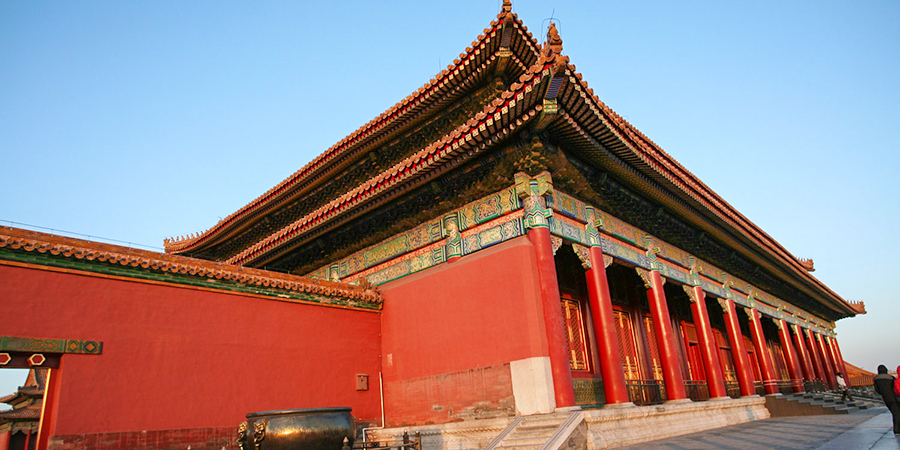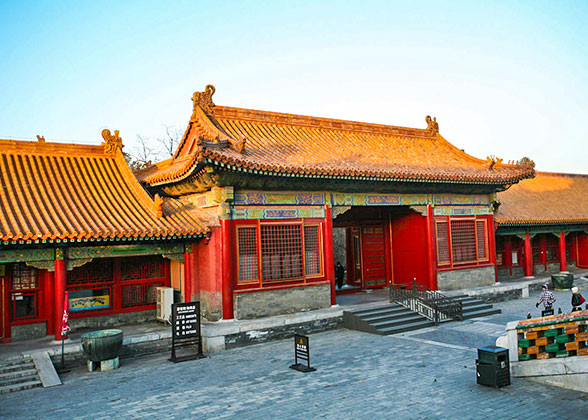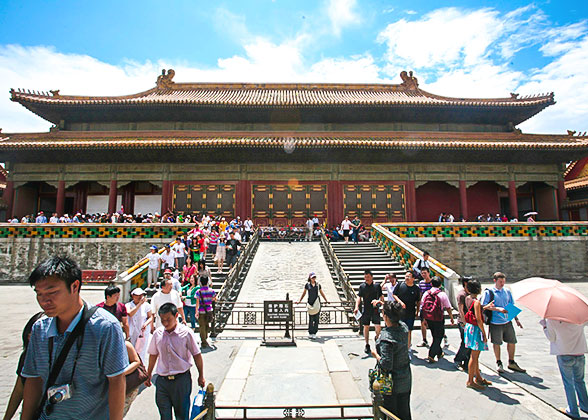Palace of Earthly Tranquility (Kunninggong)
Also named Palace of Terrestrial Tranquility or Kunninggong), the Palace of Earthly Tranquility is the last of the three main palaces in the Inner Court of the Forbidden City, standing behind the Hall of Celestial and Terrestrial Union. It was first built in 1420, and rebuilt in 1605 due to two fires in 1514 and 1596. In later years, it underwent three other restoration works. Facing south, it is 9 bays wide and 3 bays deep. Twenty-two meters high, it has a double-eaved roof with side buildings just like the Palace of Heavenly Purity but smaller.
The Palace of Earthly Tranquility was where the empress lived in the Ming Dynasty (1368-1644). However, after reconstruction in the Qing Dynasty (1644-1911), it served as the nuptial chamber of the emperor and empress and the altar for worshipping the deities of Shamanism.
The Qing emperor and empresses and the imperial household were Manchu people who were rather superstitious and respected divinity very much, thus, religious sacrifices were critical for them. In line with the customs of the Manchu, the four west side rooms of the Palace of Earthly Tranquility were alternated into an altar for offering sacrifices to the deities of Shamanism. In the third room from the east pierced two facing doors, inside which three caldrons were set to cook meat. Sacrifices were offered twice a day, one in the morning and the other in the evening. Grand occasions will be held here on Spring Festival, the first and the fifteenth day of each month, which both the emperor and empress would attend.
The two east side rooms or the East Warmth Chamber of the Palace of Earthly Tranquility were the bridal suite for the emperor and empress. The chamber wall was painted red and the palace lamps were hung high with Chinese characters meaning "double happiness" to create a warm and happy atmosphere. The screen in front was also pasted with the word as an auspicious sign, for whenever the emperor opened the door, he would see the character. The delicate and exquisite bed canopy and quilt were both embroidered with 100 children playing, hence the name "100 Children Canopy" and "100 Children Quilt".
The newly wed emperor and empress only lived in the chamber for several days, and then the emperor moved to the Hall of Mental Cultivation while the empress moved to another dwelling palace in the Forbidden City. If emperors got married before they came to the throne, they would not marry here. So, only three emperors in the Qing Dynasty, Kangxi (1662-1722), Tongzhi (1862-1874), and Guangxu (1875-1908) who ascended the throne at early ages have ever lived in this nuptial chamber. Actually, the weddings of the emperors were extremely luxurious. The wedding of Emperor Tongzhi cost 11,000,000 taels of silver while that of Guangxu cost 5,500,000 taels of silver despite the extreme poverty of the country at that time. The fitment and furnishings at the bridal suite are now what they were at the grand wedding of Emperor Guangxu.
Behind it is the Gate of Earthly Tranquility (Kunningmen) with the imperial doctors' duty room, dispensary and the eunuchs duty room flanking it.
The Palace of Earthly Tranquility was where the empress lived in the Ming Dynasty (1368-1644). However, after reconstruction in the Qing Dynasty (1644-1911), it served as the nuptial chamber of the emperor and empress and the altar for worshipping the deities of Shamanism.
The Qing emperor and empresses and the imperial household were Manchu people who were rather superstitious and respected divinity very much, thus, religious sacrifices were critical for them. In line with the customs of the Manchu, the four west side rooms of the Palace of Earthly Tranquility were alternated into an altar for offering sacrifices to the deities of Shamanism. In the third room from the east pierced two facing doors, inside which three caldrons were set to cook meat. Sacrifices were offered twice a day, one in the morning and the other in the evening. Grand occasions will be held here on Spring Festival, the first and the fifteenth day of each month, which both the emperor and empress would attend.
 |
The two east side rooms or the East Warmth Chamber of the Palace of Earthly Tranquility were the bridal suite for the emperor and empress. The chamber wall was painted red and the palace lamps were hung high with Chinese characters meaning "double happiness" to create a warm and happy atmosphere. The screen in front was also pasted with the word as an auspicious sign, for whenever the emperor opened the door, he would see the character. The delicate and exquisite bed canopy and quilt were both embroidered with 100 children playing, hence the name "100 Children Canopy" and "100 Children Quilt".
|
|
The newly wed emperor and empress only lived in the chamber for several days, and then the emperor moved to the Hall of Mental Cultivation while the empress moved to another dwelling palace in the Forbidden City. If emperors got married before they came to the throne, they would not marry here. So, only three emperors in the Qing Dynasty, Kangxi (1662-1722), Tongzhi (1862-1874), and Guangxu (1875-1908) who ascended the throne at early ages have ever lived in this nuptial chamber. Actually, the weddings of the emperors were extremely luxurious. The wedding of Emperor Tongzhi cost 11,000,000 taels of silver while that of Guangxu cost 5,500,000 taels of silver despite the extreme poverty of the country at that time. The fitment and furnishings at the bridal suite are now what they were at the grand wedding of Emperor Guangxu.
Behind it is the Gate of Earthly Tranquility (Kunningmen) with the imperial doctors' duty room, dispensary and the eunuchs duty room flanking it.
![]() You may like: Legends of Crows in the Palace of Earthly Tranquility
You may like: Legends of Crows in the Palace of Earthly Tranquility
Next:![]() Go north to see the Imperial Garden (Yuhuayuan);
Go north to see the Imperial Garden (Yuhuayuan);![]() Go west to see the Six Western Palaces (Xiliugong);
Go west to see the Six Western Palaces (Xiliugong);![]() Or go east to see the Six Eastern Palaces (Dongliugong).
Or go east to see the Six Eastern Palaces (Dongliugong).![]() Further Reading:
Further Reading:
How to visit the Forbidden City
Three Chimneys in the Forbidden City
- Last updated on Sep. 25, 2024 by Gabby Li -

